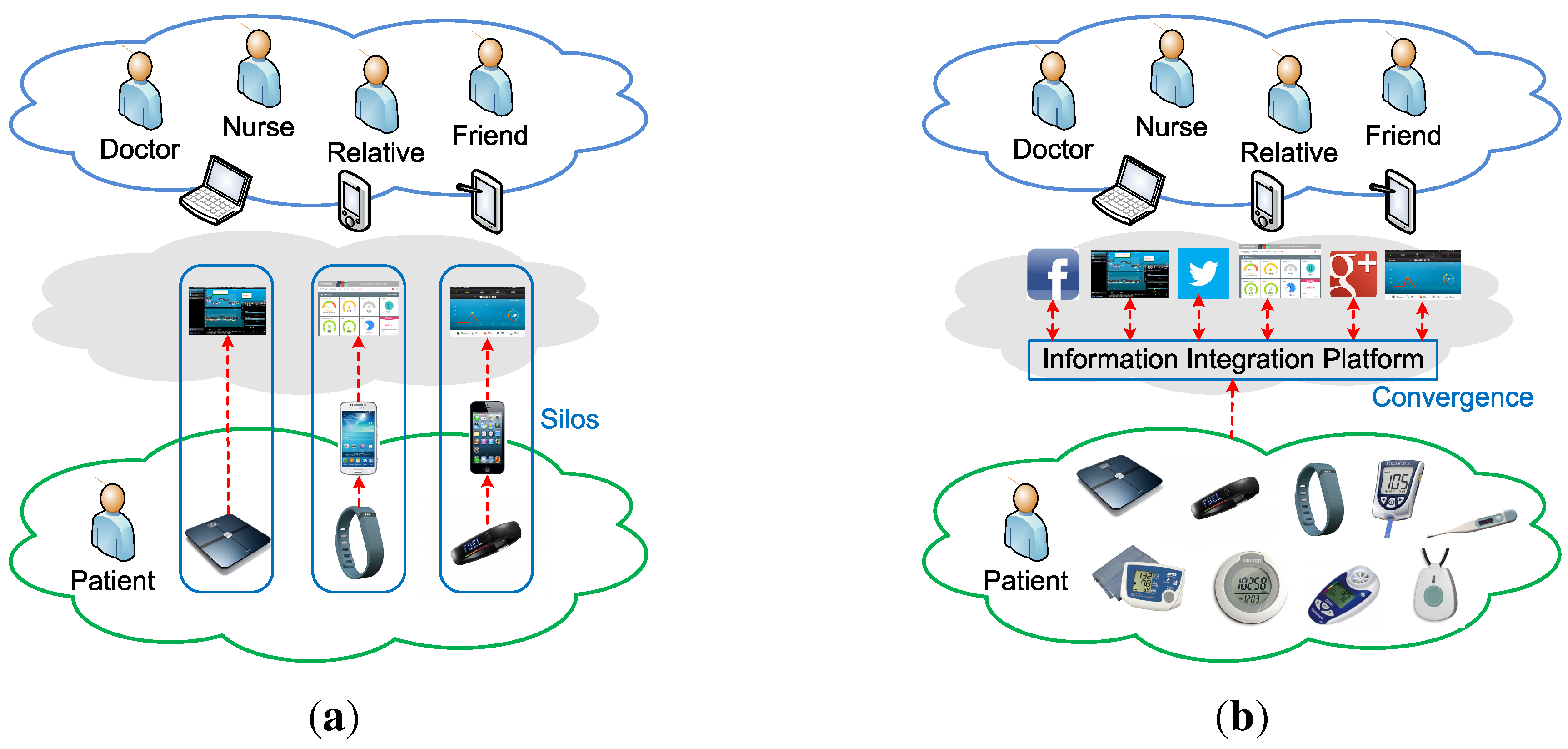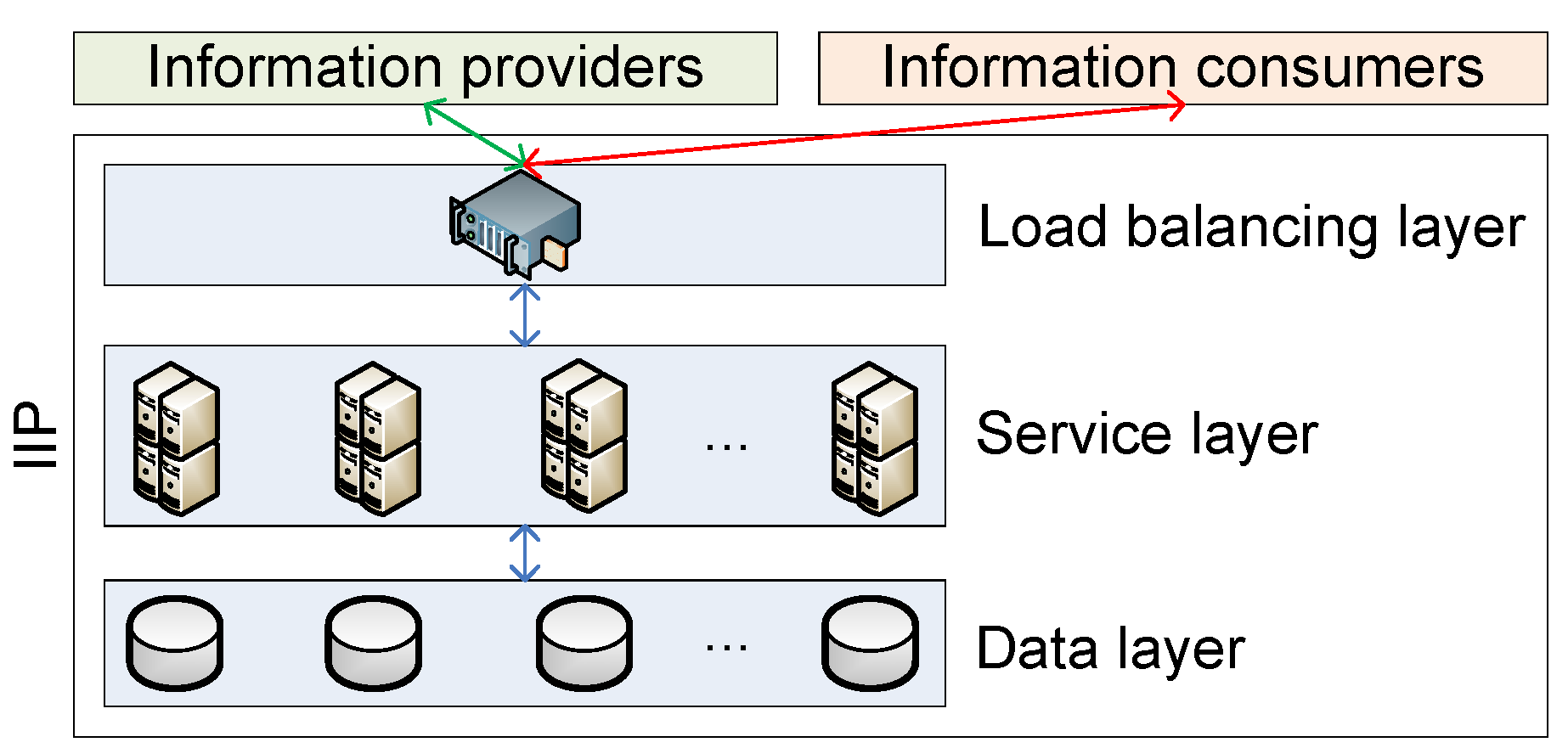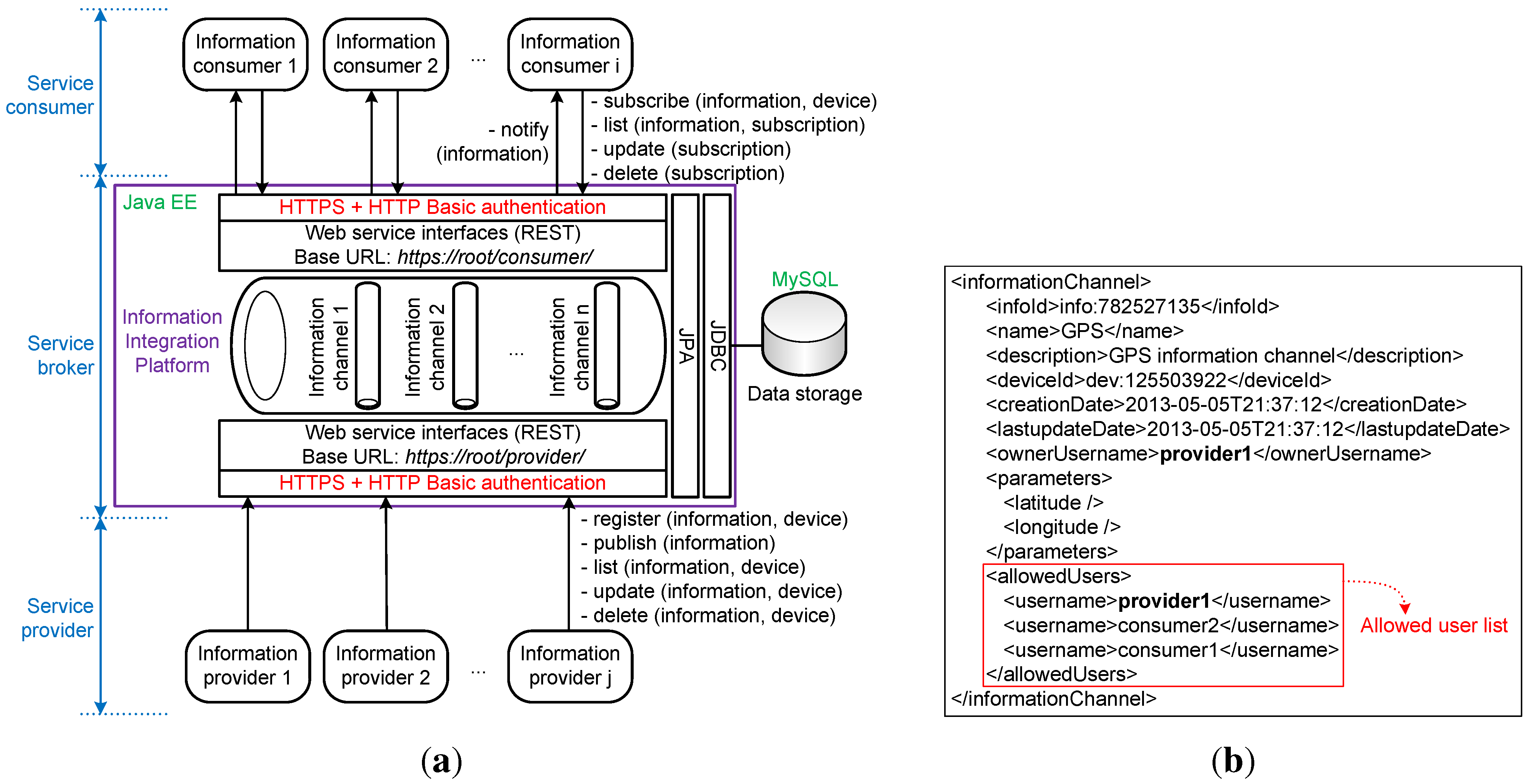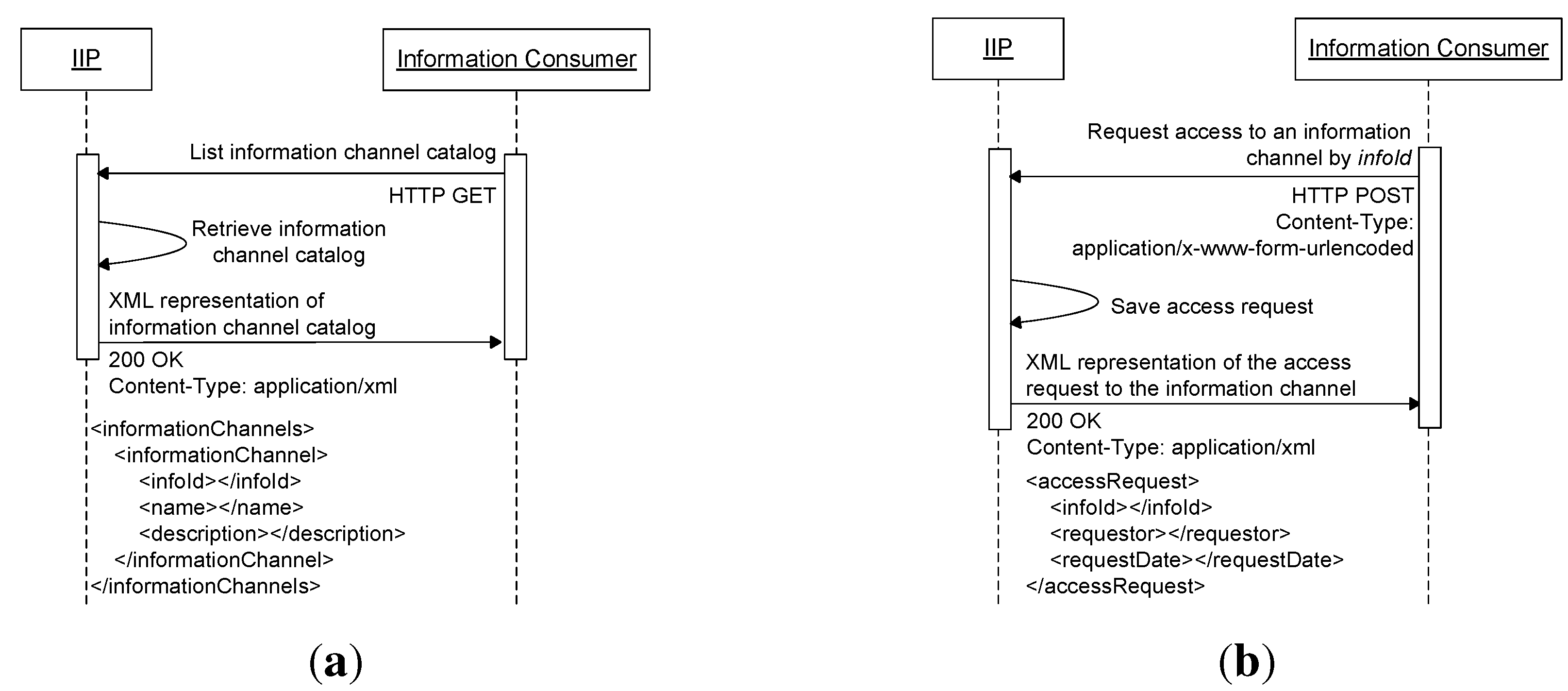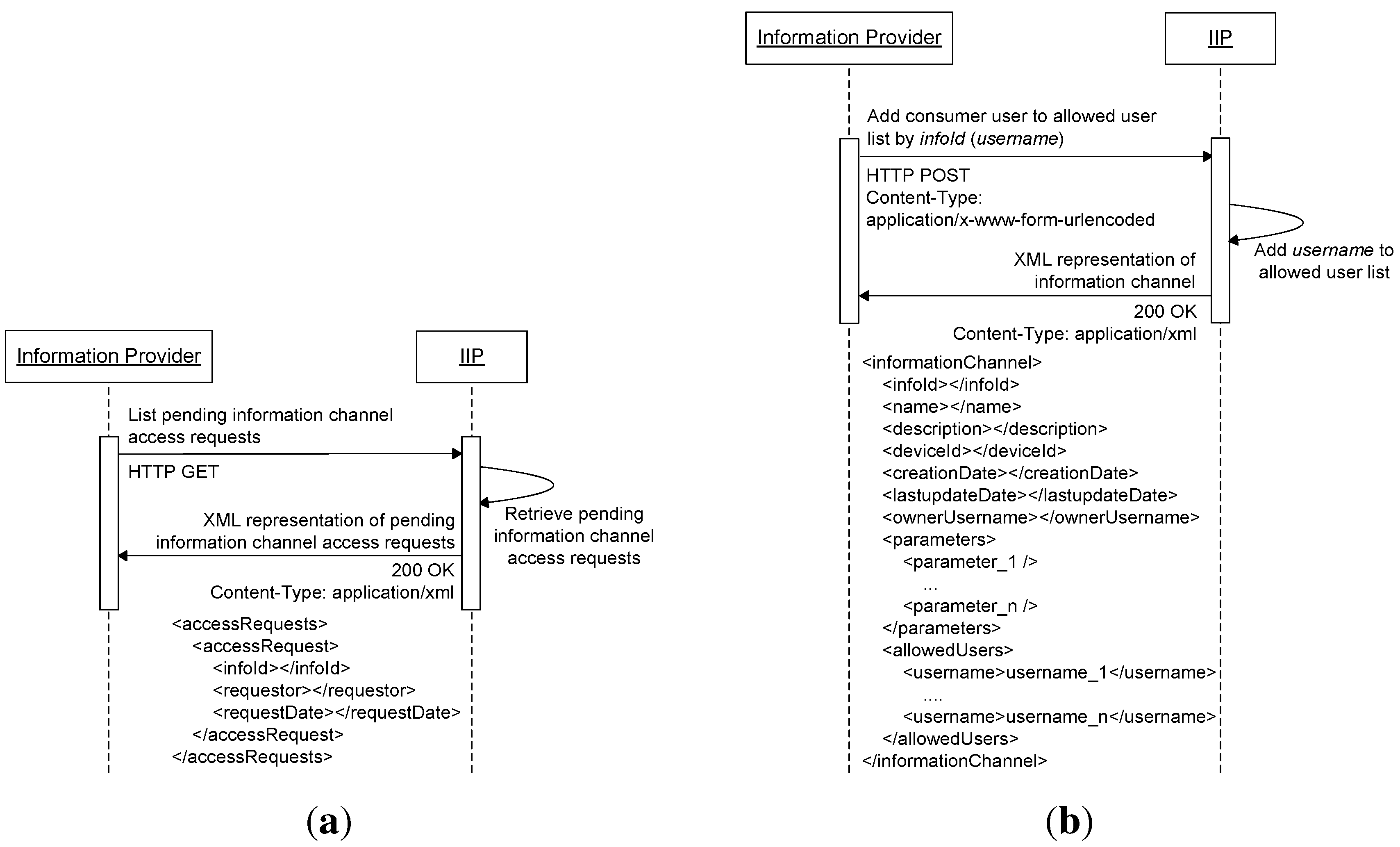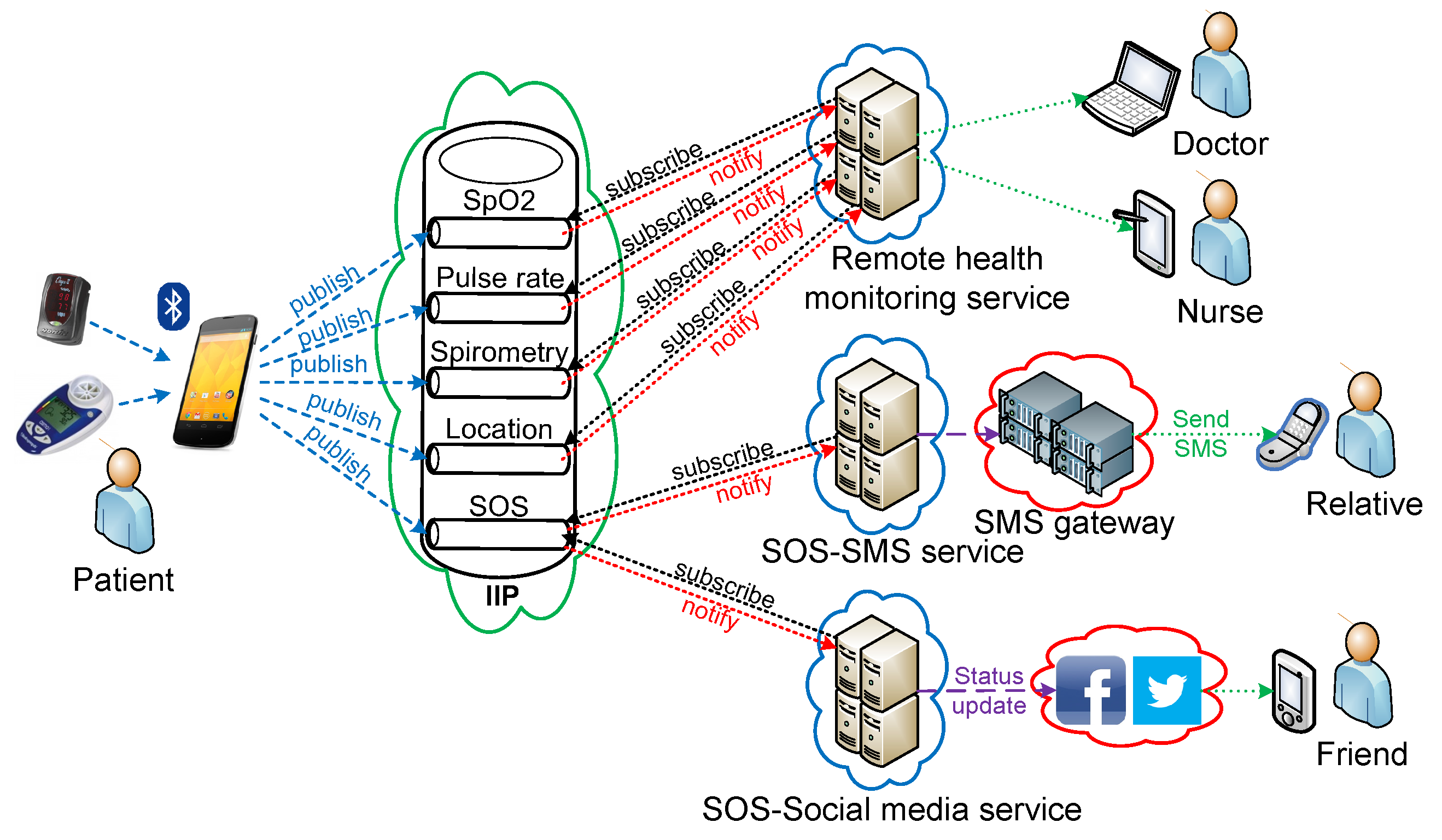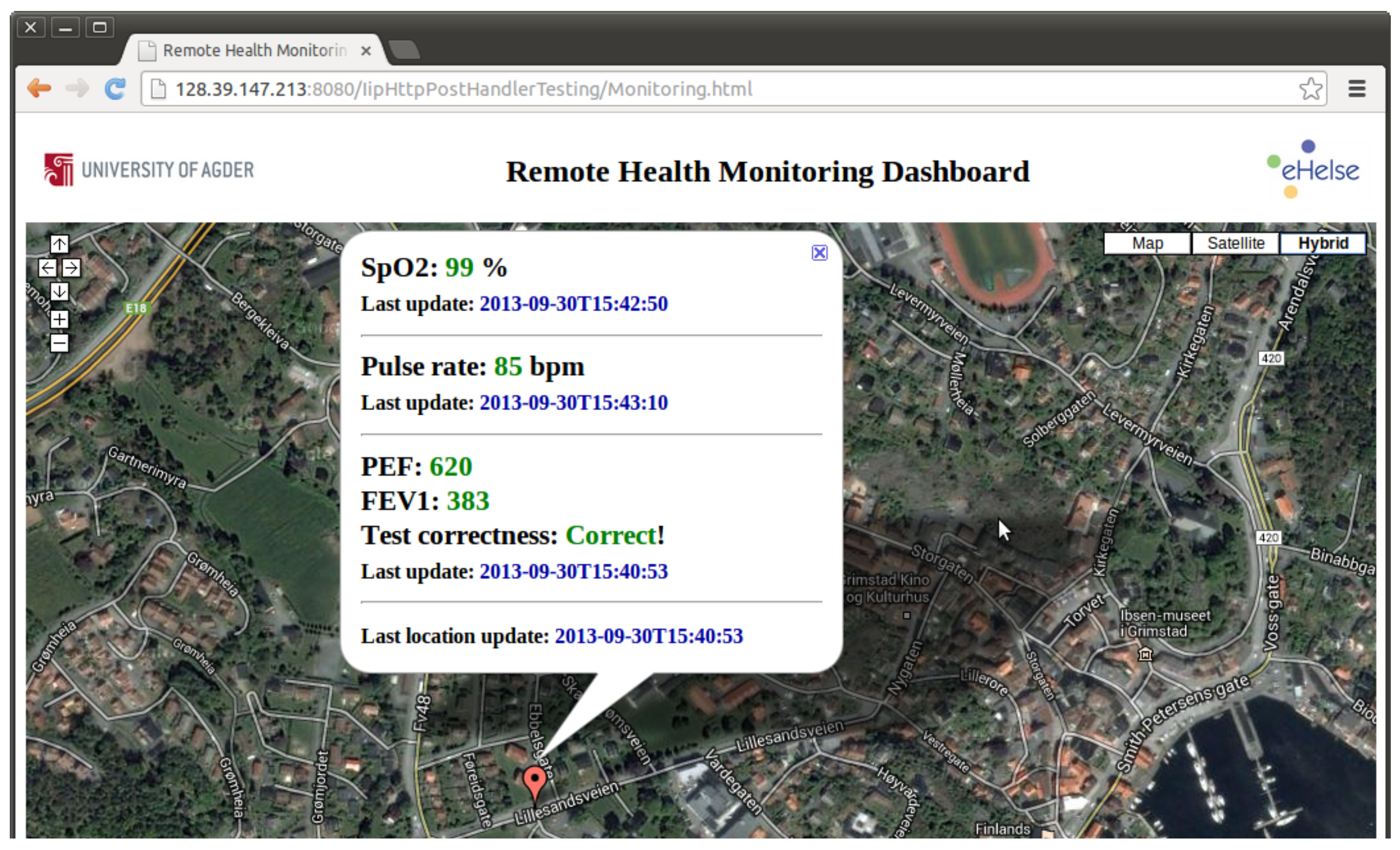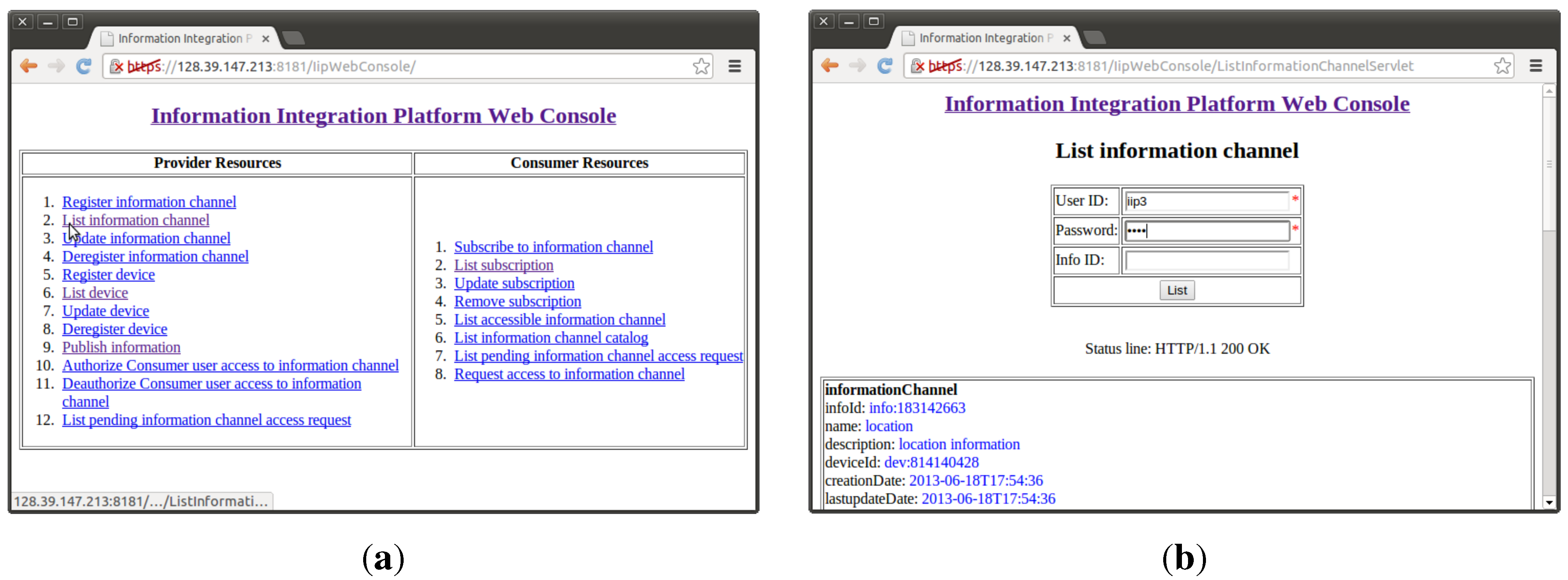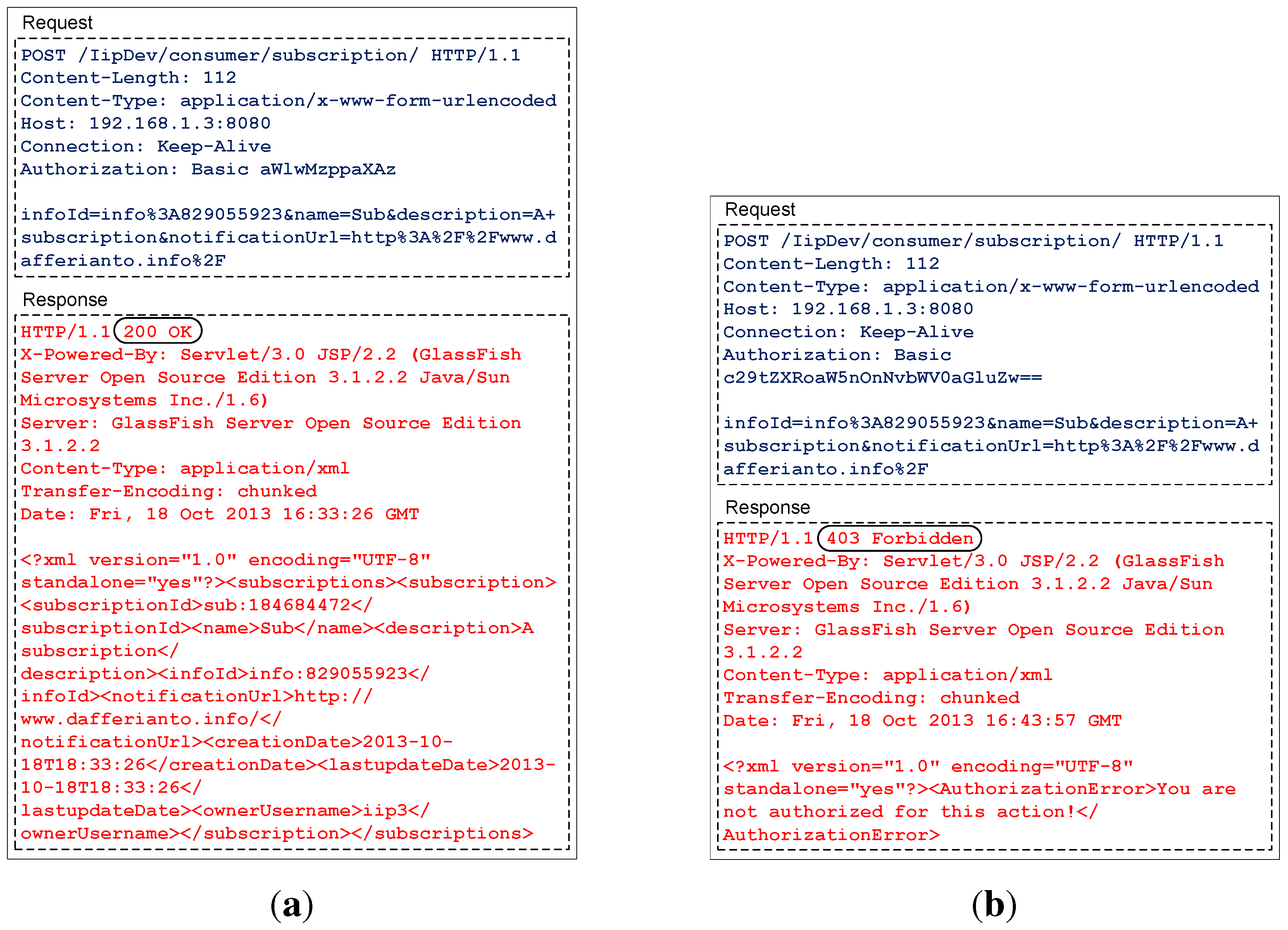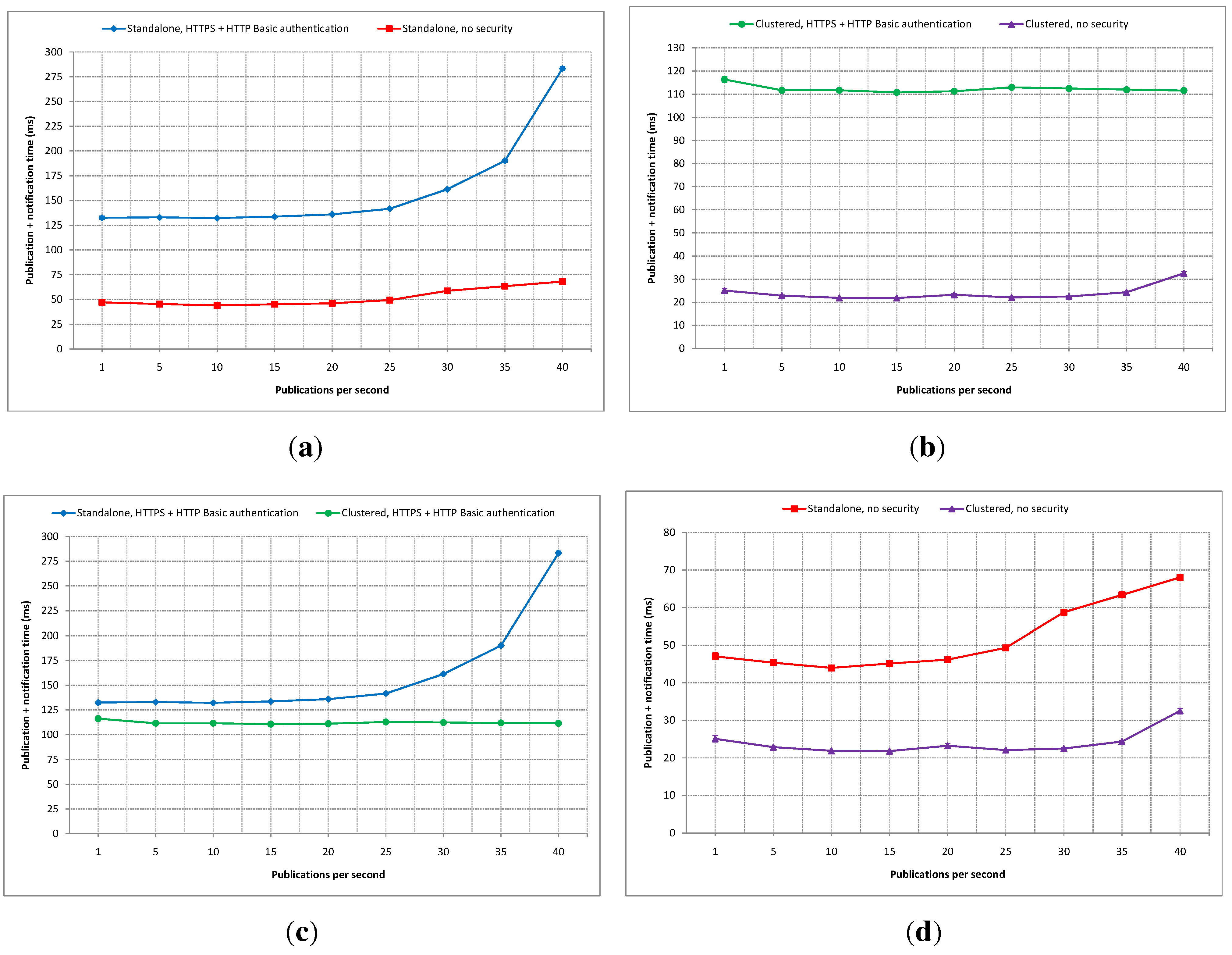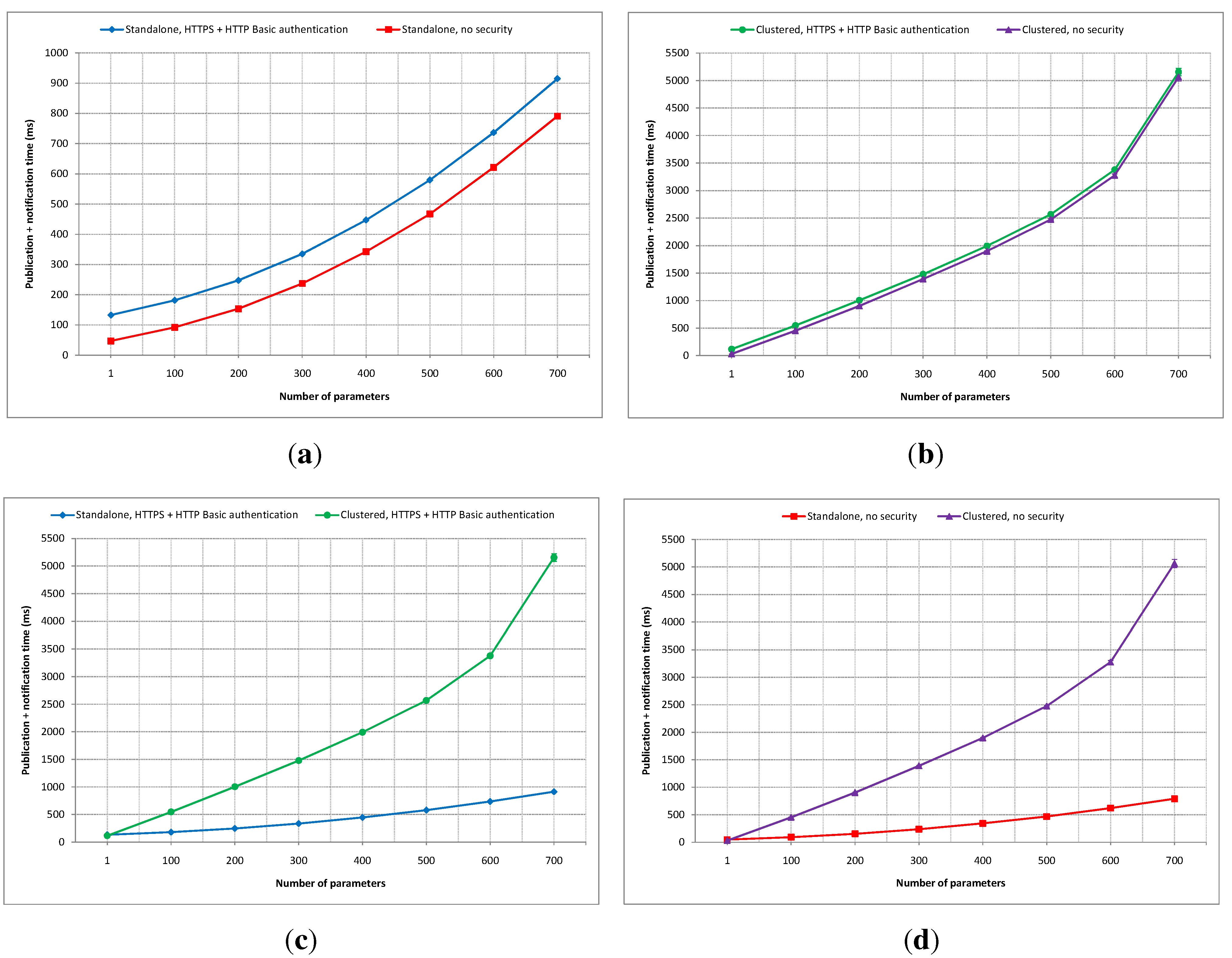1. Introduction
The term “Internet of Things” (IoT) was popularized at the Massachusetts Institute of Technology (MIT) Auto-ID Center in 1999, where a group of people started to design and propagate a cross-company radio-frequency identification (RFID) infrastructure [
1,
2]. Advancements in information and communications technology (ICT) have enabled IoT’s vision to be realized by turning everyday objects into connected objects [
3,
4], so that the information gathered (or “sensed”) by these objects can be used in various different services. Everyday objects can be employed to capture and create information from the physical world instead of relying purely on people, as normally done in traditional information systems [
1]. This is mainly achieved by using RFID and sensor technologies. The ability to react to events in the physical world automatically not only opens up new opportunities for dealing with complex or critical situations, but also enables a wide variety of business processes to be optimized. The real-time interpretation of data from the physical world can lead to the introduction of various novel services and may deliver substantial economic and social benefits [
4].
Although localized services, utilizing information gathered from nearby objects, can be useful in many different scenarios, the global pervasiveness of things can only be realized when these everyday objects are connected to the Internet [
5]. The Internet has become the
de facto standard backbone for deploying services beyond time and space barriers, which enables people or other services to consume them 24/7 from all over the world. Cloud computing has pushed the boundary even further, enabling developers with innovative ideas to develop and deploy services without large capital outlays in hardware [
6]. Myriad Internet-based services can make use of the collected information from various different everyday objects for value-added functionalities. However, everyday objects may have limitations in terms of processing power or battery lifetime, which makes it infeasible to incorporate a full transmission control protocol/internet protocol (TCP/IP) stack [
7] in order to communicate with the current Internet infrastructure. Other more power-preserving communications protocol stacks (e.g., Bluetooth, ZigBee, ANT) are more commonly used in embedded devices. In order to be connected to the Internet, additional gateway devices that have implemented full TCP/IP stacks are needed. These gateway devices should have at least two network interfaces, one facing the connected objects and another one facing the Internet, and physically can range from dedicated servers to mobile devices (e.g., smartphones, tablets). The latter is particularly useful for scenarios that involve the mobility of the users [
8]. With the increasing needs of everyday objects to be connected to the Internet, new technologies have been developed to extend the Internet to small devices [
9,
10], such as Internet protocol version 6 (IPv6) over low-power area networks (6LoWPAN) [
11,
12] and GLoWBALIPv6 [
13].
When everyday objects are connected to the Internet (e.g., through a smartphone gateway), an application-layer protocol is needed to communicate with Internet-based services that are interested in using the gathered information. Within the web domain, hypertext transfer protocol (HTTP) [
14] has been widely used to exchange content over the Internet [
15] since the inception of the World Wide Web (WWW) [
16]. Web services, which are software systems designed to support interoperable machine-to-machine interaction over a network, normally use HTTP to convey messages, as well. This is true for both traditional web services [
17] and RESTful web services [
18]. The majority of Internet-based services provide web service interfaces to enable message exchange with external systems. Thus, the HTTP protocol, combined with the web service approach, is a good combination to be used for message exchange in the application layer.
The IoT plays an important role in healthcare, for example, in general remote vital sign monitoring of patients [
19], as well as in specific chronic disease treatment, such as diabetes therapy management [
20]. Within the personal healthcare sector, many portable and wearable medical and fitness devices are being pushed to the consumer market by various vendors. This can be seen as a positive trend towards the self-empowerment of a healthier lifestyle and enables healthcare workers to more efficiently keep track of their patients’ health conditions by means of telecare, if such a feature is provided. Many vendors provide additional online services for devices they sell, enabling users to better visualize, store and share the gathered information from the devices through the Internet. However, many of these services are integrated with the devices following a closed vertical “silo” approach [
21], where the devices can only be used with the provided services, and different services from other vendors cannot make use of the gathered information. The main disadvantage of this situation is the inability to combine information gathered from different devices produced by different vendors for better reasoning and decision making [
22,
23]. To solve this issue, open interfaces (e.g., web service interfaces) have to be provided by device vendors, so that service developers can incorporate the information collected from the devices in their services.
A common way to integrate devices and Internet-based services is to directly exchange messages between the two parties in a point-to-point manner. The downside of this approach is that devices that “sense” new information should deliver it to all services that are interested in consuming it, either through a push approach from the devices or in a pull fashion from the services. This can be a major drawback from an energy efficiency standpoint, as portable and wearable connected devices commonly run on batteries, and thus, sending similar information to many destinations (
i.e., services) will lead to a shorter lifetime of the devices. With the proliferation of mobile cloud computing usage in recent years [
24,
25,
26], a brokered approach with a service broker being deployed in the cloud can be a good alternative, since the devices need to connect to the Internet in order to communicate with Internet-based services anyway. The service broker will handle the message delivery tasks to all interested services, so that the devices only need to send the collected information once. A publish/subscribe messaging pattern is advantageous in such a broker, so that services interested in specific information can subscribe to that particular information and get notification from the broker whenever new information is available. However, such a service broker can be seen as a single point of failure, since various devices and services rely on it, and thus, its dependability is very crucial. An information integration platform (IIP), which acts as a service broker between connected devices and Internet-based services, has been proposed and developed as a prototype. Several services within the healthcare domain, mainly related to telecare, have been developed on top of the platform, as well. This paper will briefly describe the main functionalities of the platform, while focusing more on its dependability aspects. Prototype services on top of it will be described to put the platform into a deployment context within the healthcare domain.
3. Conceptual Design
The IIP aims to bridge the communications between everyday objects (
i.e., information providers) and Internet-based services (
i.e., information consumers), acting as a service broker between the two entities. This broker is expected to break the information reusability issue in a vertical “silo” integration approach that has been chosen by many personal wearable device vendors, including within the healthcare sector; see
Figure 1a.
Figure 1.
(a) Point-to-point “silo” integration; (b) Brokered converged integration.
Figure 1.
(a) Point-to-point “silo” integration; (b) Brokered converged integration.
Patients are faced with various healthcare-related devices from different vendors in their daily activities, and the information these devices gather is commonly only used by specific services provided by the devices’ vendors. Other Internet-based services have no or very limited possibilities to utilize such information, so it is common that similar information is redundantly gathered by different devices for their own services. This tight coupling between devices and services can be solved if device vendors provide open APIs that enable service developers to make use of the gathered information in their services. However, the integration normally still follows a point-to-point approach, as shown in
Figure 1a, where each service is directly communicating with each device that provides the information. The downside of such point-to-point integration is, from the information providers’ (
i.e., device) perspective, that they have to send newly gathered information to different services that are interested in using it. This is particularly an issue for battery-powered wireless devices. A brokered approach, as shown in
Figure 1b, tackles this issue by delegating the information distribution task to the broker, so that information providers only need to send newly collected information once to the service broker. The service broker provides convergence for information gathering from various different devices that the patients encounter.
3.1. General Architecture
The IIP, which plays the service broker role, primarily aims to be deployed in the cloud for global reachability, although it is possible to deploy it in a closed environment, such as in smart homes. RESTful web service interfaces are used facing both information providers (
i.e., devices) and information consumers (
i.e., Internet-based services), as they are widely used within the web domain.
Figure 2a shows the main functionalities of the IIP.
Figure 2.
(a) Main functionalities of the information integration platform (IIP); (b) Additional functionalities of the IIP.
Figure 2.
(a) Main functionalities of the information integration platform (IIP); (b) Additional functionalities of the IIP.
In general, the IIP provides RESTful web service interfaces for both information providers (service providers from the SOA standpoint) and information consumers (service consumers from the SOA perspective) that manage the information flow from information providers to information consumers. These resources are divided into two categories with two main web resource-based uniform resource identifiers (URIs), namely
https://root/provider/ and
https://root/consumer/. The root part of the URI refers to the domain of the specific IIP deployment. Information is managed in different information channels, and information providers should initially create information channels before being able to pass through information they gather. The IIP provides resources for information providers to register new information channels with varying parameters, to list their information channels, to update/modify their information channels, to publish new information to their information channels and to delete/remove their information channels. In addition, the IIP provides resources for information consumers to list existing information channels, to subscribe to existing information channels, to update/modify their subscriptions to existing information channels and to delete/remove their subscriptions to existing information channels. When an information consumer subscribes to an existing information channel, it should provide a notification uniform resource locator (URL), which acts as an end-point for IIP to deliver notifications of newly published information from an information provider who owns that particular information channel. An information provider can register many information channels, but an information channel can only be associated with one information provider (
i.e., the owner). This makes the relationship between information provider and information channel a one-to-many relationship. On the other hand, an information channel can be accessed/subscribed to by many information consumers, and an information consumer can access/subscribe to many information channels. This makes the relationship between information channel and information consumer a many-to-many relationship. These relationships are shown in
Figure 3. An article, which was written earlier by the author, describes how these functionalities work in a more detailed manner [
46], including sequence diagrams and the contents of message exchanges. This work is a continuation of the author’s previous work, addressing several aspects in the future work section of the previous article.
In addition to the main functionalities as previously described, the IIP provides resources for access control between different credentials within the IIP, as shown in
Figure 2b.
Figure 3.
Relationships between the information provider, information channel (in the IIP) and information consumer.
Figure 3.
Relationships between the information provider, information channel (in the IIP) and information consumer.
Since the IIP acts as a broker between information providers and information consumers, dependability becomes a crucial aspect that should be investigated. There are several definitions of dependability, but in general, it is commonly recognized as an integrative concept that encompasses different attributes. Littlewood and Strigini [
47] suggested that dependability attributes include reliability, safety, security and availability. Avižienis
et al. [
48] defined attributes of dependability to comprise availability, reliability, safety, confidentiality, integrity and maintainability. In this latter view, security is not seen as a standalone attribute, but rather as a combination of three attributes, namely confidentiality, integrity and availability. This is in line with the confidentiality, integrity and availability (CIA) triad model [
49], which commonly acts as a fundamental guideline to help secure information systems by providing a measurement tool for security implementations. The following subsections will cover the dependability aspects of the IIP that relate to security and availability, including scalability.
3.2. Security and Privacy
Information is passed around between information providers and information consumers through the IIP, and thus, communications between the three entities should be secured. Since REST interfaces are used in IIP, the communications security relies heavily on the application layer protocol used by these REST interfaces. In contrast to traditional web services technology that has a solid standardized security stack, such as WS-Security [
50], RESTful web services do not have predefined and/or standardized security methods. Although RESTful web services were initially designed to be technology-agnostic [
18], it has been commonly associated with the HTTP protocol. Thus, many of its security features are mainly inherited or simply adopted from the ones used for HTTP-based applications. Transport layer security (TLS), in the form of HTTP secure (HTTPS), has been the main ground for RESTful web services security, which provides a secure point-to-point communications channel on top of the transport layer.
The HTTP basic access authentication scheme, which was initially specified in the HTTP/1.0 specification, provides a simple authentication mechanism to access resources on a web server (based on URIs) by means of username and password. This scheme is not considered to be a secure method of user authentication, as the username and password are transmitted through the network as plain text (unless used in conjunction with other secure transport mechanism, such as HTTPS). Nevertheless, the combination of HTTPS and HTTP basic authentication in many cases is enough for securing resources on a web server, as everything being sent through the wire is encrypted.
From IIP’s perspective (as shown in
Figure 2a), information providers are applications that relay information from devices used by patients to information channels in the IIP. Likewise, information consumers are applications that consume/use information by subscribing to information channels in the IIP. To strengthen the privacy of information being exchanged between different applications through the IIP, access control to information channels should be maintained by the IIP. Identity-based access control is utilized, and an access control matrix is maintained. Information channels are registered by information providers (
i.e., the owners), and each information channel has exactly one owner who can publish information (add new information) to the registered information channel (write access to the information channel). The access control matrix is used for authorizing information consumers to access/subscribe to information channels (read access to information channels). An information provider has the privilege of specifying which credentials (e.g., usernames in HTTP basic authentication scheme) have read access (
i.e., can subscribe) to information channels it owns.
Table 1 shows an example of an access control matrix maintained by the IIP.
Table 1.
Access control matrix for read access to information channels.
Table 1.
Access control matrix for read access to information channels.
| Usernames | Channel_1 | Channel_2 | … | Channel_n |
|---|
| username_1 | YES | YES | | NO |
| username_2 | NO | YES | | YES |
| ⋮ | | | | |
| username_m | NO | NO | | YES |
The rows in
Table 1 represent the capabilities of users (information consumers) in the IIP, and the columns represent access control lists of information channels. Information consumers can list all information channels (by utilizing a catalog service provided by the IIP), but they can only access/subscribe to information channels listed in their capabilities lists. Since one of the IIP’s main responsibilities is to manage information channels, the access control matrix can be simplified to access control lists only (
i.e., the columns in
Table 1). Whenever an information provider adds/removes a user (
i.e., an information consumer) from/to its allowed user list of a specific information channel it owns, the IIP will update the access control list of the corresponding information channel.
Figure 4 shows the relationship between an information provider and its registered information channels with their allowed user lists. The IIP provides additional functionalities, as shown in
Figure 2b, for managing access to information channels. Information consumers are provided with resources for listing information channels (information channel catalog service), requesting access to information channels and listing their pending access requests to information channels. Information providers, on the other hand, are provided with resources for authorizing access to information channels that belong to them (adding allowed users to their allowed user lists), deauthorizing access to information channels that belong to them (removing allowed users from their allowed user lists) and listing pending access requests to their information channels.
The identity-based access control to different information channels is meant to be used by applications (both information providers and information consumers). User identities in this case are application identities, not users of the applications (e.g., patients, nurses). These identities are used for controlling what information different applications can or cannot use, where the information is generated by other applications. However, these identities, which are used in the IIP, can also be directly mapped to user identities in the information consumer applications if required (e.g., a patient ID as a username in the IIP). Finer degrees of access control can be implemented by information consumer applications, for example, utilizing a role-based access control (RBAC) to group individual users of the applications.
Figure 4.
Allowed user lists of information channels belonging to an information provider.
Figure 4.
Allowed user lists of information channels belonging to an information provider.
3.3. High Availability and Scalability
Despite the positive aspects of the IIP as an integration platform between things and services that provides information distribution convergence, as shown in
Figure 1b, centralized service brokers, such as the IIP, are architecture-wise a single point of failure, since all information providers and information consumers communicate with and rely on it. High availability becomes a crucial factor for successful deployment of the IIP to ensure services receive information from devices in a timely manner and continue to work properly (
i.e., reliable). High availability is not a new topic in itself, as typical client-server systems require servers to run 24/7, with uptime as close to 100% as possible, accepting requests from client applications. Redundancy is the key to high availability, where service components are duplicated in different nodes, so that if one service component fails, another similar component will take over its tasks. In general, high availability can be achieved in either master/slave or master/master mode. In master/slave mode, a server instance (
i.e., the master) is in charge of providing services to the clients’ requests, while another server instance (
i.e., the slave) is running idle. When the master instance fails, a monitoring entity (
i.e., the manager) will hand over the master’s tasks to the slave instance. On the contrary, all server instances are treated as masters in master/master mode, all providing services to client requests. The manager is responsible for monitoring and handling any conflict that might arise between concurrent changes made by different master instances. A load balancer can be added in front of master instances, so that client requests can be distributed according to the processing capability of the master nodes (e.g., requests are evenly distributed among master nodes when they have similar processing capability).
The IIP utilizes master/master mode for high availability with an additional load balancer as proxy for handling client requests (both from information providers and consumers). This will make the IIP seem to be a single entity from both the information providers’ and consumers’ perspectives, but its components are redundantly distributed among different nodes. This approach allows the scalability aspect to be incorporated, as well, enabling new nodes to be added when the current serving nodes are reaching their peak (i.e., fully loaded) in handling incoming requests. Scalability becomes important when the number of information providers and consumers using the IIP is not fixed. IIP nodes should be flexible enough to scale horizontally by the addition of new commodity servers when the number of participating information providers and consumers grows.
With regard to high availability and scalability, a simple three-layer system architecture is used by the IIP for deployment, as shown in
Figure 5.
Figure 5.
Three-layer system architecture for IIP deployment.
Figure 5.
Three-layer system architecture for IIP deployment.
The load balancing layer acts as a proxy service, where both information providers and consumers send requests. The requests are then forwarded to one of the application servers in the service layer that hosts the main logic of the IIP (
i.e., the IIP application) based on the load balancing criteria maintained by the load balancer. In the service layer, the IIP’s functionalities, as shown in
Figure 2a,b, are realized and exposed through RESTful web service interfaces. All information that needs to be stored, such as information channels, allowed user lists, information channel subscriptions and the actual information of the information channels, are persisted in the data layer. By adopting this three-layer architecture, the IIP’s components can be made redundant and can be scaled up according to deployment needs (e.g., add application nodes when more processing capability is needed, add data nodes when bigger storage capacity is required).
5. Evaluation
The implemented IIP prototypes, both standalone (i.e., all components in one dedicated host) and clustered (i.e., the components are spread in several different hosts), have been deployed and tested to work as intended in laboratory environment. This section will briefly present several aspects of the IIP that have been tested and verified, as well as performance benchmarking, which provide inputs on how to further improve the current implementation.
5.1. Information Channel Access Management
As described in the previous section, HTTPS is used for securing message exchanges between information providers, consumers and the IIP, by means of encryption. This will minimize the success rate of man-in-the-middle attacks. To maintain information privacy between applications, HTTP basic authentication credentials are directly used in IIP for authorizing applications to access different information channels. Information consumers that are not listed in an information channel’s allowed user list will not be able to access or subscribe to that particular channel.
Figure 15a shows a test case where an HTTP POST request is sent from a test client application, acting as an information consumer, to the IIP for subscribing to an information channel with
infoId info:829055923. The username, which is used by the information consumer, is listed in the information channel’s allowed user list, and thus, a 200 OK response is returned by the IIP, containing a representation of the subscription in XML format in its body.
Figure 15b shows another test case where similar HTTP POST request for subscription to the same information channel is sent from an information consumer. This time, however, the username used by the information consumer is not listed in the information channel’s allowed user list, and therefore, the IIP returns a 403 Forbidden response with an XML-formatted message in its body, informing that the username is unauthorized to subscribe to the targeted information channel. All messages in both tests (
Figure 15a,b) are captured using Wireshark, and HTTPS is not used (otherwise all packets are encrypted and cannot be interpreted). It can be concluded from the conducted tests that the implemented information channel access management scheme by directly utilizing HTTP basic credentials works as intended.
Figure 15.
Wireshark captures of: (a) An information consumer successfully subscribes to an information channel; (b) An information consumer is rejected when trying to subscribe to an information channel.
Figure 15.
Wireshark captures of: (a) An information consumer successfully subscribes to an information channel; (b) An information consumer is rejected when trying to subscribe to an information channel.
The tests were conducted manually, since they were only intended to verify whether the access management implementation worked correctly. Automated unit testing could be used instead for a more formal way of verification, and protocol conformance testing could be applied, as well, to find out whether the implemented features comply with the chosen standards.
5.2. High Availability and Load Balancing
Seven hosts (machines) are used for deploying the clustered prototype of the IIP, where one is utilized as a proxy server for load balancing requests from both information providers and consumers, two are used for deploying the main applications that handle requests forwarded (load balanced) by the proxy/load balancer host, another two are employed for data and SQL nodes of the MySQL Cluster that act as the main storage for the IIP and the last two are utilized for management nodes of the MySQL Cluster. This set-up conforms with
Figure 9 and can be considered as the minimum requirement for IIP’s high availability, where all nodes have exactly one redundant backup (except the load balancer). New nodes can be added when deemed needed. A test was conducted to review the general functionality of the load balancing between the redundant nodes being deployed. A test client application was developed, playing the role of information provider that keeps sending one publication message per second to one of its information channels through the load balancer host. Initially, both application servers’ hosts are up and running, and the load balancer host distributes the requests evenly to both application servers. As can be seen in
Figure 16a, the load balancer host (acting as a proxy) successfully forwards all requests evenly to both application servers’ hosts (
i.e., 53 and 52 requests for
worker1and
worker2, respectively). One of the two application servers’ hosts was then turned off during the test, leaving only one application server available for handling all requests. From
Figure 16b it can be seen that the load balancer host forwards all requests to the available application server’s host (
worker2), and
worker1’s state was changed to error. From this test, it can be concluded that the redundancy of the application nodes works well for providing highly available service, while enabling new nodes to be added (horizontal scaling) and load balanced to serve incoming requests.
Figure 16.
Snapshot of mod_jk status worker: (a) Both application nodes are up and running; (b) One application node (worker1) is down.
Figure 16.
Snapshot of mod_jk status worker: (a) Both application nodes are up and running; (b) One application node (worker1) is down.
In the data layer, synchronous replication among data nodes is handled automatically by the MySQL Cluster, which is monitored and managed by the management nodes.
Figure 17a depicts a snapshot of a MySQL Cluster management client that describes the most current configuration of the cluster and the status of each node. In this set-up, any data committed from the service layer is inserted into both data nodes synchronously. One of the two data and SQL nodes’ hosts (with IP address 192.168.1.7) was shut down. The MySQL Cluster then saves all data and writes to only one existing data node, as shown in
Figure 17b. When the host is up and running again, MySQL Cluster automatically synchronizes all changes to the newly running data node.
Figure 17.
Snapshot of ndb_mgm client showing the most current MySQL Cluster configuration: (a) Both data and SQL node hosts are up and running; (b) One data and SQL node host (192.168.1.7) are down.
Figure 17.
Snapshot of ndb_mgm client showing the most current MySQL Cluster configuration: (a) Both data and SQL node hosts are up and running; (b) One data and SQL node host (192.168.1.7) are down.
5.3. Performance Benchmark
A dedicated multi-threaded client application was developed for performance benchmarking. The application acts as an information provider that constantly publishes information to the IIP with a predefined time interval for a certain period. Another client application, which subscribes to an information channel that belongs to the information provider application, was developed to receive notifications from the IIP, playing the role of information consumer. The main aim of this evaluation was to compare the performance of the standalone IIP prototype with the clustered version in terms of one complete flow of publication and notification average time. In addition, comparisons between the inclusion of the security and privacy scheme and also without it were conducted.
All experiments were carried out in a laboratory environment, where all hosts (machines) were deployed in an isolated network with a switch as the connecting point (there is no connection to an external network, such as the Internet). Experiments in a standalone set-up involve three hosts: one for the information provider application, one for the IIP (all-in-one, single point of failure) and one for the information consumer application. Experiments in a clustered set-up make use of nine hosts: one for the information provider application, seven for the IIP (as described earlier) and one for the information consumer application. All hosts that are used for deploying the IIP (both the standalone version and its clustered counterpart) have similar specifications (i.e., Intel Core 2 Duo 2.4 GHz processor, 8 GB RAM running Linux Ubuntu 12.04 LTS). Another two hosts that deploy the information provider and consumer applications also have similar specifications (i.e., Intel Core 2 Duo 2.4 GHz processor, 4 GB RAM running Linux Ubuntu 12.04 LTS). All application servers’ configurations are kept similar with almost no optimization from their default settings to ensure fairness in the comparisons.
5.3.1. Publication Rate as a Variable
Four experiments were conducted in this category. All variables are fixed, except the publication rates of the information provider application, which were varied between one and 40 publications per second, and all publication and notification messages contain only one parameter. The first experiment applied the security measures (i.e., HTTPS and HTTP basic authentication) in a standalone IIP set-up, while the second experiment did not incorporate any security mechanism, also in a standalone set-up. The third and fourth experiments were conducted in a clustered IIP set-up, where security was applied in the third experiment and was ignored in the fourth experiment. Each measurement in all experiments lasted five minutes, generating 300 to 12,000 data messages (depending on the publication rate). Each measurement was performed three times to ensure data consistency, and the first 1% of the captured data is removed from every measurement to avoid the start-up effect of the application servers in serving incoming requests. All measurement data were averaged and plotted alongside confidence intervals at the 95% confidence level.
Figure 18.
Publication and notification time comparisons with publication rate as variable: (a) Standalone secure vs. insecure; (b) Clustered secure vs. insecure; (c) Secure standalone vs. clustered; (d) Insecure standalone vs. clustered.
Figure 18.
Publication and notification time comparisons with publication rate as variable: (a) Standalone secure vs. insecure; (b) Clustered secure vs. insecure; (c) Secure standalone vs. clustered; (d) Insecure standalone vs. clustered.
Figure 18a shows a comparison of total average publication and notification times between the secured and non-secured standalone IIP set-ups. It can be seen that the average difference at one publication per second is about 85 ms, which is the rough estimate of the security scheme’s overhead in the standalone set-up. This average difference does not change much with the increase of the publication rate until around 30 publications per second. From there, the difference gap grows larger significantly.
Figure 18b shows a comparison of similar latency measurements as in
Figure 18a, except that the compared experimental results are between secured and non-secured clustered versions of the IIP. In a clustered set-up, the starting difference between secured and non-secured implementations is about 90 ms, slightly higher than in the standalone set-up. This difference gap is maintained in a relatively stable manner up to 40 publications per second. From
Figure 18a,b, it can be seen that the clustered version of the IIP can handle the increase of the publication rate better than its standalone counterpart, especially with the security scheme being applied.
A latency comparison between secured standalone and clustered IIP set-ups is depicted in
Figure 18c. The average difference gap is stabled at about 20 ms up to around 25 publications per second, and then, it grows more than two times. This can be viewed as the lesser ability of the standalone IIP set-up in handling faster publication rates compared to the clustered set-up.
Figure 18d shows a latency comparison for publication and notification between non-secured standalone and clustered IIP set-ups. The average difference stays almost unchanged at about 20 ms from one to 25 publications per second, and the gap slightly widens as the publication rate increases.
From the four experiments conducted in this category (i.e., publication rate as a variable), it can be concluded that the clustered deployment of the IIP handles higher rates of publications better than the standalone set-up. Even at lower rates, the total average latency for publication and notification are smaller in the clustered set-up, although only by a small margin. The inclusion of the security scheme adds additional overhead to the overall processing times in both standalone and clustered set-ups. The confidence intervals are very small compared to the mean values in all experiments. However, all experiments were carried out with only one parameter inside the publication and notification messages. In the next category of experiments, the number of parameters will be used as a variable.
5.3.2. Number of Parameters as a Variable
Experiments in this category were carried out to see how a different number of parameters affects the overall performance of the implemented platform in both standalone and clustered versions. In
Figure 10, for example, the SpO2, the pulse rate and the SOS information channels use one parameter each; the location information channel has two parameters, while the spirometry information channel has 13 parameters for each measurement.
Four experiments were conducted in this category, but unlike the previous category, the publication rate is fixed at one publication per second in order not to load the application servers. The number of parameters is varied instead, ranging from one to 700 parameters. Each measurement in all experiments lasted five minutes, generating 300 data. Each measurement was performed three times to ensure data consistency, and the first 1% of the captured data is removed from every measurement to avoid the start-up effect of the application servers in serving incoming requests. All measurement data are averaged and plotted alongside their confidence intervals at the 95% confidence level, just like in the previous category.
A comparison of total average publication and notification times between the secured and non-secured standalone IIP deployments is shown in
Figure 19a. The time difference starts at about 85 ms when one parameter is used, and the gap increases almost linearly to around 125 ms when 700 parameters are used. This gap represents the implemented security mechanism’s overhead in the standalone IIP set-up.
Figure 19b depicts a comparison of publication and notification latency between the secured and non-secured clustered IIP set-ups. The time difference is stabled across all measurements at about 90 ms. From
Figure 19a,b, it can be seen that the additional overhead of the security mechanism does not change much with the increased number of parameters being used for both standalone and clustered deployments of the IIP.
Figure 19.
Publication and notification time comparisons with the number of parameters as the variable: (a) Standalone secure vs. insecure; (b) Clustered secure vs. insecure; (c) Secure standalone vs. Clustered; (d) Insecure standalone vs. clustered.
Figure 19.
Publication and notification time comparisons with the number of parameters as the variable: (a) Standalone secure vs. insecure; (b) Clustered secure vs. insecure; (c) Secure standalone vs. Clustered; (d) Insecure standalone vs. clustered.
A comparison of the average latency difference between secured standalone and clustered IIP deployments is shown in
Figure 19c. When only one parameter is used, the clustered set-up outperforms its a standalone rival with around a 20 ms difference. However, the clustered deployment suffers more latency overhead compared to the standalone version with the increasing number of parameters being used. With 100 parameters used, the clustered deployment performs worse than its standalone counterpart by around 365 ms, and it is further worsened as the number of parameters being used is increased.
Figure 19d shows a comparison of average publication and notification times between non-secured standalone and clustered IIP set-ups. Almost similar to
Figure 19c, the clustered version in this experiment wins in terms of the latency difference compared to its standalone counterpart by about 20 ms when only one parameter is used, but it suffers when the number of parameters increases. When 100 parameters are used, the clustered set-up falls short by around 360 ms in latency performance compared to the standalone deployment.
From the four experiments in this category (i.e., the number of parameters as the variable), it can be concluded that the clustered set-up of the IIP performs better than the standalone set-up when the number of parameters being used is low. The latency increase rate is higher for the clustered version compared to the standalone deployment as the number of parameters being used grows. This can be seen as a direct impact of the synchronization process between data nodes in the data layer, since synchronizing large amounts of incoming new data takes much more time than writing directly to one data store. The use of the security mechanism adds overhead to both standalone and clustered set-ups, but the processing times are not affected significantly with the increasing number of parameters being used. The confidence intervals are very small compared to the mean values in all experiments.
6. Conclusions and Future Work
An information integration platform (i.e., the IIP) has been designed and developed to bridge communications between everyday objects and Internet-based services, breaking the traditional vertical “silo” approach of integration. This broker platform follows an event-driven SOA paradigm with a publish/subscribe messaging pattern and exposes its functionalities through a set of RESTful web services. An identity-based access control is used and has been implemented in the prototype to ensure information privacy between service clients (i.e., information providers at the everyday objects’ side and information consumers at the Internet-based services’ side). Only the owners of information channels in the IIP can publish new information to their information channels (i.e., write access), and only information consumers that are listed in an information channel’s allowed user list can subscribe to that particular information channel for notifications (i.e., read access). Information consumers can request access to different information channels, and information providers have full rights to add or remove information consumers from/to the allowed user lists of information channels they own. Three services within the healthcare domain have been developed, namely remote health monitoring service, SOS-SMS service and SOS-social media service. This shows how the platform can be utilized to enhance quality of life by means of novel personalized services for patients, in particular, and to society, in general. To avoid a single point of failure, a three-layer deployment architecture of the IIP has been implemented, supporting high availability and scalability by employing redundancy of service components, as well as clustering technology with load balancer. The IIP prototype has been tested to work as intended, and some experiments have been conducted to compare the average total publication and notification times between the standalone IIP deployment and the clustered version, as well as between the inclusion of the security scheme and without it. From the experiments with the current prototypes, it can be concluded that the clustered deployment of the IIP can handle better higher publication rates compared to its standalone counterpart when the number of parameters being used is low. The standalone set-up outperforms the clustered version when the number of parameters increases. In both cases, the incorporation of the security mechanism adds latency overhead.
The HTTP protocol is used by the IIP for message exchanges with both information providers and consumers, due to its pervasive usage on the web. Newer and lighter protocols that are specifically designed for embedded devices, such as the CoAP and the message queue telemetry transport (MQTT), are planned to be supported in the next version of the IIP, especially for interfacing with information providers. JavaScript Object Notation (JSON) will also be supported in the next implementation iteration as an alternative data format to the currently used XML, so that information consumers can choose which data format they prefer for the notifications.
The developed healthcare services described in this article are rather simplistic and straightforward, utilizing only a handful of devices as data sources. On the other hand, the IIP is designed to mediate a wide spectrum of information from a variety of information providers, supporting different application areas. More sophisticated context-aware services that combine information from various different devices, such as home appliances in a smart home environment to assist patients with living independently in their homes, are planned to be developed in the near future.
Optimizations in all three layers of the proposed architecture for deployment are planned to be conducted in the continuation of this work, and further security and privacy enhancements will be investigated and incorporated in the next prototyping round. Additionally, the current IIP prototype is planned to be used in several pilot projects that include real-life patients within the healthcare domain in collaboration with several hospitals and partner companies. In turn, they will provide feedback on how the system could further be improved.
